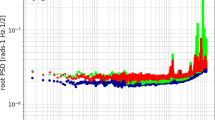Abstract
Following the occurrence of the 1995 Hyogoken-Nanbu (Kobe) earthquake, National Research Institute for Earth Science and Disaster Prevention (NIED) has constructed two strong motion seismograph networks, K-NET and KiK-net. These networks cover uniformly the country with an inter-station interval of about 20–25 km, and a total number of the stations is about 1,700. To grasp the hazard (ground motion) of urban or downtown areas, most stations of K-NET are located in public offices, schools and parks, and a three-component accelerometer is installed on the free-surface. On the other hand, KiK-net stations are located in quiet places to avoid the artificial noise. Each KiK-net station has a borehole of 100 m or more in depth and strong motion seismographs have been installed both on the ground surface (uphole) and at the bottom of the boreholes (downhole ). Recently, based on the request for quicker hazard information, all instruments of the K-NET and KiK-net have been renewed by including the change of accelerometers at the surface, new recorders, and also a new data collection system between stations and the Data Management Center (DMC) in Tsukuba. The newly developed instruments, which are state of the art in strong motion instrumentation, have several advantages such as real-time capability, larger measurable range and lower noise. This paper explains the new generation system of K-NET and KiK-net.
Access this chapter
Tax calculation will be finalised at checkout
Purchases are for personal use only
Similar content being viewed by others
References
Aoi S, Obara K, Hori S, Kasahara K, Okada Y (2000) New strong-motion observation network: KiK-net. EOS trans. Am Geophys Union 81:F863
Boore DM (2001) Effect of baseline corrections on displacements and response spectra for several recordings of the 1999 Chi-Chi, Taiwan, earthquake. Bull Seismol Soc Am 91:1199–11211
Eguchi T, Fujinawa Y, Fujita E, Iwasaki S, Watabe I, Fujiwara H (1998) A real-time observation network of ocean-bottom-seismometers deployed at the Sagami trough subduction zone, central Japan. Mar Geophys Res 20:73–94
Fukuyama E, Ishida M, Hori S, Sekiguchi S, Watada S (1996) Broadband seismic observation conducted under the FREESIA Project. Rep Nat’l Res Inst Earth Sci Dsas Prev 57:23–31
Geographical Survey Institute (1998) Crustal deformation of Japan detected GEONET. http://mekira.gsi.go.jp/ENGLISH/index.html. Accessed 29 Jan 2010
Kinoshita S (1998) Kyoshin net (K-NET). Seismol Res Lett 69:309–332
Kunugi T (2000) Relationship between Japan meteorological agency instrumental intensity and instrumental modified mercalli intensity obtained from K-NET strong-motion data. Zisin2 53:89–93
Kunugi T, Aoi S, Nakamura H, Fujiwara H, Morikawa N (2008) A real-time processing of seismic intensity. Zisin2 60:243–252
Obara K (2002) Hi-net: high sensitivity seismograph network, Japan. Lect Notes Earth Sci 98:79–87
Obara K, Shiomi Y, Haryu Y, Matsumura M, Shimanuki T (2008) Development of network platform for data transmission and practical use for NIED Hi-net system. Japan geoscience union meeting 2008:S144–P012
Odaka T, Ashiya S, Tsukada S, Sato S, Ohtake K, Nozaka D (2003) A new method of quickly estimating epicentral distance and magnitude from a single seismic record. Bull Seismol Soc Am 93:526–532
Okada Y, Kasahara K, Hori S, Obara K, Sekiguchi S, Fujiwara H, Yamamoto A (2004) Recent progress of seismic observation network in Japan – Hi-net, F-net, K-NET and KiK-net – . Earth Planets Space 56:15–28
Peterson J (1993) Observations and modeling of seismic background noise. USGS Open File Rep. 93-322
Shabestari KT, Yamazaki F (2001) A proposal of instrumental seismic intensity scale compatible with MMI evaluated from three-component acceleration records. Earthq Spectra 17:711–723
Shiomi K, Obara K, Aoi S, Kasahara K (2003) Estimation on the azimuth of the Hi-net and KiK-net borehole seismometers. Zisin2 56:99–110
Tomioka T, Yamamoto S (2006) Development of Low Noise Accelerometer (JA-40GA), Japan Aviation Electronics technical report 29:14. http://www.jae.co.jp/gihou/gihou29/pdf/g_14.pdf. Accessed 29 Jan 2010
Wessel P, Smith W (1995) New version of the generic mapping tools released. EOS trans. Am Geophys Union 76:329
Author information
Authors and Affiliations
Corresponding author
Editor information
Editors and Affiliations
Appendix
Appendix
Rights and permissions
Copyright information
© 2011 Springer Science+Business Media B.V.
About this chapter
Cite this chapter
Aoi, S., Kunugi, T., Nakamura, H., Fujiwara, H. (2011). Deployment of New Strong Motion Seismographs of K-NET and KiK-net. In: Akkar, S., Gülkan, P., van Eck, T. (eds) Earthquake Data in Engineering Seismology. Geotechnical, Geological, and Earthquake Engineering, vol 14. Springer, Dordrecht. https://doi.org/10.1007/978-94-007-0152-6_12
Download citation
DOI: https://doi.org/10.1007/978-94-007-0152-6_12
Published:
Publisher Name: Springer, Dordrecht
Print ISBN: 978-94-007-0151-9
Online ISBN: 978-94-007-0152-6
eBook Packages: Earth and Environmental ScienceEarth and Environmental Science (R0)




